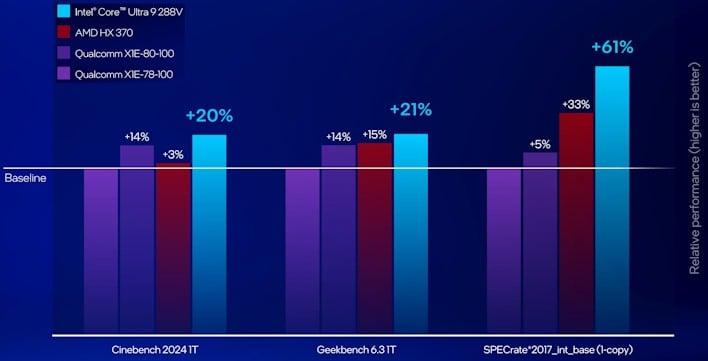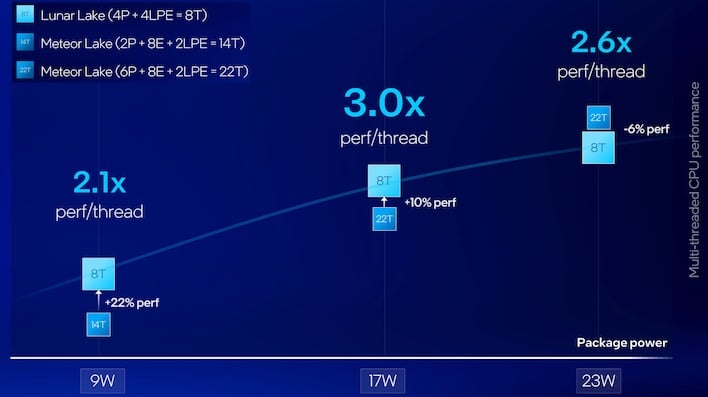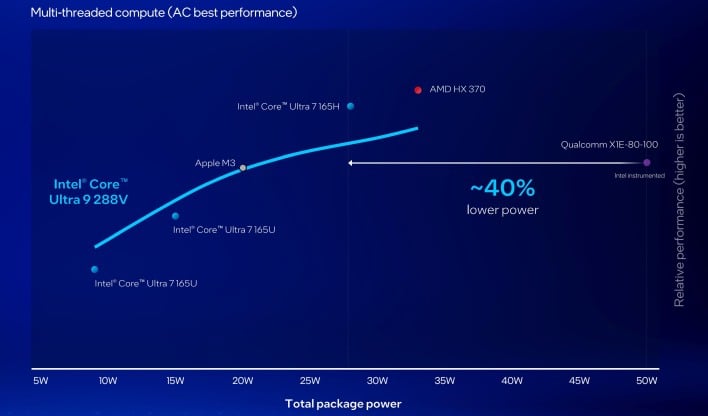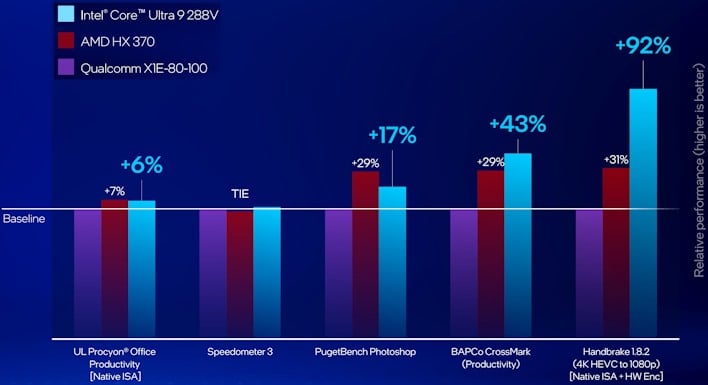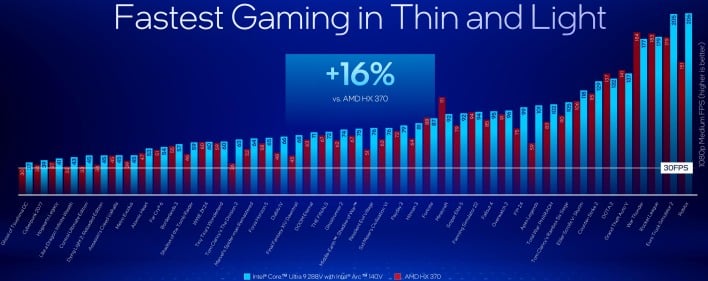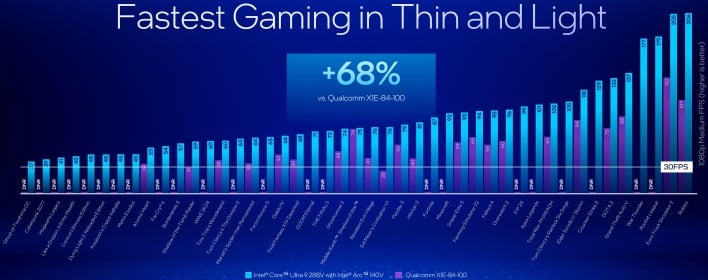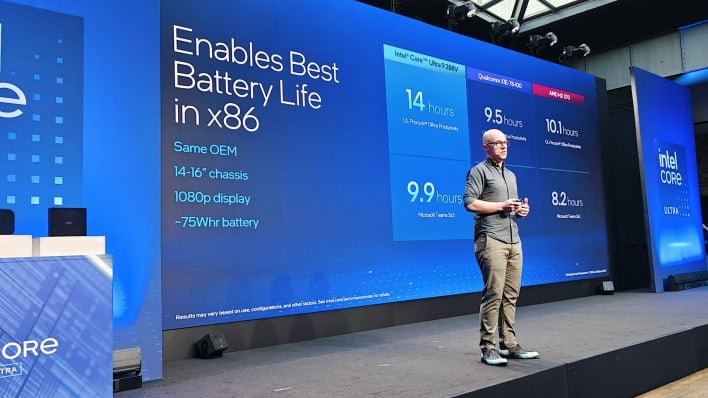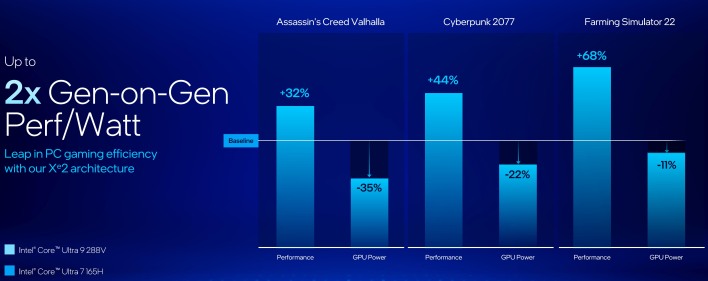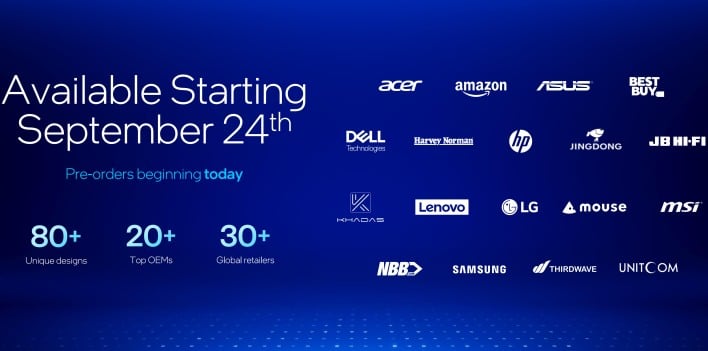Core Ultra 200V Benchmarks Revealed, Intel's Bold Performance Claims Validated
Today's launch has been a long time coming. We've seen Lunar Lake in action multiple times already, and been impressed by Intel's live demos. However, the numbers the company is putting out today are nothing short of astonishing. Obviously, take these with a grain of salt because these are manufacturer-provided numbers. However, if the reality is anything even close to this, well—Intel is back with a vengeance.
As you'll hear in this exclusive interview with Intel's Robert Hallock, he (and the company as a whole) are very bullish on Lunar Lake. Hallock claims Intel's got the fastest CPU core out there, with highly competitive graphics and leading AI performance as well. Efficiency should also be a significant step up versus previous-gen architectures as well.
We're not going to go real hard on the specifications of Lunar Lake; if you're interested in learning about these processors, we've already written up a huge six-page deep dive on their design and architectures for your perusal. The slide above summarizes the key points if you're in a hurry. You get four Lion Cove P-cores and four Skymont E-cores; both of these are brand new core architectures. Lion Cove, at least as implemented here, does not have Hyper-Threading, so this is an 8-core, 8-thread CPU.
The GPU is likewise based on new silicon. In this case, it's using the very same design that will power upcoming Battlemage discrete GPUs. It has just eight Xe2-cores, but that's a little misleading as each core is now twice as wide as it was in the previous generation. The NPU is radically upgraded from Meteor Lake as well, offering up to 48 TOPS of AI compute thanks to a much wider compute engine and revised NPU 4 architecture.
Intel Core Ultra 200V Processor Models
Before we get to the benchmark numbers, let's take a look at the SKUs. There are nine variations of the Core Ultra 200V processors launching today, except there actually aren't. Four of the nine models are fundamentally identical to other models, except that they only include 16GB of RAM on package instead of the full 32GB. This doesn't have any performance implications outside of the lower memory capacity, thankfully.
If you're confused as to why your choice of CPU model affects the memory capacity, that's because these parts come with their RAM on package. Functionally, in practical, end-user terms, it's really no different from having the RAM soldered on the motherboard—if some of it fails, you have to replace the whole board anyway. However, moving the RAM on package allows Intel to drastically reduce latency and power consumption.
What kind of effect does that have on performance? A big one. Intel says that its Lion Cove P-cores are "the fastest cores. period." It compares the Core Ultra 9 288V to a pair of Snapdragon X Elite chips as well as an AMD Ryzen AI 9 HX 370 and claims a victory by 20% or more over the slower of the two Qualcomm chips. However, it's still handily beating both of the other competitors, particularly in SPEC where Lion Cove pulls out a massive victory.
While the new Core Ultra "Series 2" CPUs only have eight CPU cores, they actually drastically outperform the 22-thread Meteor Lake parts at 17W, and at the higher 23W power limit, they're only 6% behind. Consider that those chips have six P-cores and ten E-cores against the four and four of Lunar Lake, and that's really something. This is really an efficiency win more than a performance win, but it's still impressive.
The slide above shows multi-threaded throughput when hooked up to AC and giving the best possible performance. It's a pretty interesting slide. In this sort of condition, the new Core Ultra 200V series falls behind both the 12-core AMD Ryzen 9 HX 370 as well as the Core Ultra 7 165H—but again, remember that we're talking about chips with twelve and sixteen cores here. Lunar Lake's 4+4 config isn't far behind, and it's apparently matching the performance and energy usage of the Apple M3, which is great for a Windows machine.
As far as productivity goes, Intel pits Lunar Lake against the usual suspects and actually admits some losses to the much bigger AMD APU. However, it apparently dominates in BAPCo Crossmark's Productivity benchmark as well as Handbrake video encoding. That's using the integrated GPU's hardware encoder, mind you, so this isn't a CPU benchmark at all. Still very impressive stuff, though, and both x86 companies are significantly outrunning Qualcomm here.
Intel Core Ultra 200V Gaming And AI Benchmarks
How about some gaming on thin & light laptops? The integrated graphics on Meteor Lake were already quite capable of handling some light gaming, but the Core Ultra Series 2 takes it to a whole other level. In fact, Intel says that these parts are even faster than AMD's Ryzen AI 9 HX 370, which is astonishing. AMD does definitely take away some benchmarks, but assuming Intel's methodology holds up here, this is outstanding performance from Xe2.
The comparison against Qualcomm tells a different type of story. A full 23 of the 45 games that Intel used for benchmarking simply do not work on Qualcomm's processor, and the rest perform relatively poorly. The only game where Qualcomm is competitive is Middle-Earth: Shadow of War; Intel claims 68% average performance advantage against the Snapdragon X Elite X1E-84-100, which is the fastest variant in laptops.
How about some AI benchmarks? The state of software support for NPUs is in its infancy right now, and Intel's benchmarks exemplify that. In the UL Procyon Computer Vision benchmark, Intel puts up a commanding lead with INT8 precision, and it's the only company with an NPU that can finish the benchmark at FP16 precision. AMD's Strix Point NPU is potent, but weak software support is like an albatross around the neck of those chips. Meanwhile, Qualcomm's NPU is similarly speedy, but more limited in its capabilities.
AMD's integrated RDNA 3.5 Radeon is great for gaming, but lacks matrix math units (or "tensor cores" in green team parlance), so it struggles to compete against Intel's Core Ultra 9 288V and its XMX-enabled Xe2 iGPU in the Stable Diffusion benchmark on GPUs. Meanwhile, Qualcomm's part can't even run this test; Intel simply marks down a "Did Not Run" result.
Intel really goes for the throat on Qualcomm here. These tests are all AI benchmarks, ranging from Blender, Handbrake, and Adobe suite software. Qualcomm's part struggles against the last-gen Core Ultra 7 155H, while the new Core Ultra 9 288V apparently runs away with some of the benchmarks by as much as 1800%.
Intel Core Ultra 200V Lunar Lake Battery Life
Of course, arguably the most important benchmark for a laptop processor is its power efficiency. Meteor Lake was reasonably efficient, but it got handily beaten by first Qualcomm's Snapdragon X Elite processors and then AMD's Strix Point Ryzen AI 300 CPUs. Intel wasn't going to take that lying down. As you can see in the slide behind Intel's Robert Hallock above, the company claims that in three laptops from the same OEM using similar-sized batteries, the Core Ultra 9 288V offers far superior battery life versus both of its competitors.
Intel promises double the performance-per-watt in gaming, too. The slide above shows the Core Ultra 9 288V beating the Core Ultra 7 165H soundly in games while drawing as much as 35% less power. Intel promised us back at Computex that Xe2 was going to knock our socks off, and with results like this, we can't wait to see what Battlemage looks like.
This image shows the layout of Lunar Lake, and the really notable things here are that the chip supports both HBR3 mode for DisplayPort 2.1 as well as three simultaneous Thunderbolt 4 connections. That means you can hook up three high-refresh-rate 4K displays to one of these chips simultaneously, all powered off of its integrated graphics. You also get a pretty fair amount of external connectivity, including four PCIe 5.0 lanes for an SSD.
If you're sold on Lunar Lake, you'll be able to pre-order one ASAP. Laptops sporting Intel's Core Ultra Series 2 processors are starting pre-orders today from over 20 "top OEMs" including familiar names like Acer, Asus, Dell, hp, Lenovo, LG, MSI, Samsung, and so on. Actually, we have a second post taking a look at some of the machines that are on display at IFA Berlin right now, so head over there and take a peek at the new systems on the way. Those laptops will apparently be arriving September 24th, just a little under 3 weeks from now.



